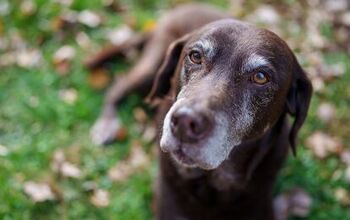How Do I Know When Walks Are Too Much for My Senior Dog?

Big or small, all dogs love to get out for a good walk each day. And if your favorite route is one designed to challenge your pooch and offer him a rigorous workout, you may be finding that as he ages, his spirit is willing, but his body is slowing him down.
So, how can you tell if that lengthy outing, brisk pace, or rough terrain is becoming too much for your older dog? We’re sharing some tips on what to look for as well as some alternatives that will help keep him feeling fit and looking forward to heading out.
Schedule Active Time
Regardless of your dog’s age, he should be getting 30 to 60 minutes of exercise each day. If it sounds like a lot for your older pet, break it down into 2 or 3 short walks each day. For a working breed (think Labrador Retriever, Rottweiler Border Collie to name a few) or dogs who have always been highly active, lean toward the 60-minute daily goal to help keep him in shape and mentally stimulated. By maintaining a regular walk or active-play schedule, you prevent weight gain and the painful joint issues that accompany those extra pounds.
Watch for Fatigue
Be prepared to taper your pet’s activity if he begins to show signs of pain or of tiring out at any time during your outing. What else to be watching for?
1. Does your pooch now lag behind you during walks? For some, this may be normal but if your dog has typically been happy to walk alongside or ahead of you, this may be a sign he’s going to need an adjustment to the length or type of walk you’re taking him on.
2. Is your typically social dog now reluctant to run and play with others at the leash-free park? Or has he become less interested in rough-housing with other pets in your household?
3. Is he no longer enthusiastic when you pull out the leash for his morning walk? Some dogs may even retreat to their bed, blanket, or sofa to indicate their reluctance to head out.
4. Do you notice him limping as you wind up your walks, or struggling with hills or stairs?
5. Does he seem to need more recovery time after each outing? Is he immediately heading over to his bed, the sofa, or crate to rest when returning home, rather than bouncing around and looking for snacks?
Adapting Exercise for a Senior Dog
Your dog needs to remain active to keep him both mentally and physically fit. So, when you begin to notice your pet is struggling due to age, it’s time to modify his activity to match his changing abilities.
· If you hike on trails that typically include rocky terrain or any type of hill that requires agility and climbing, look for options that are flat or gently sloped. And remember, going down hills can be as tricky for an older dog as going up them.
· For those regular walks that used to cover a few miles at a time, it may be time to break them down into shorter distances that you and your dog can complete over the course of a full day. And don’t forget that whatever distance you cover, he needs to be able to make it back as well.
· If you’re noticing that concrete or hard surfaces seem to exacerbate your dog’s joint issues, consider woodland trails or a leash-free park that offers a softer, more natural terrain including grass, dirt, or crushed run.
· Catching Frisbees may now be off the roster of activities but a gently tossed ball that lands 10 or 20 feet away is something your pet can comfortably fetch and return to you. Best of all, it can help stimulate his need for a job.
· If your household includes both younger and older dogs (like mine), tailor your walks to meet both their needs. Pick low-grade trails with frequent pockets of shade. And schedule plenty of rest stops/water breaks along the way.
· If you notice that even the shorter walks seem to have your dog limping in the end, consider swimming. It’s a great exercise that gets him moving but with zero stress on those tender joints.
· If your walks begin with a car ride to a dog park, it may be time to invest in a ramp that makes entry and exit from your vehicle, easier for you and less stressful for your pooch.
· Consider the weather when heading out with Rover. Extreme heat (even if you pack plenty of water and use a dog cooling vest) can knock him out of commission pretty quickly. And during winter, an older dog feels the cold faster than a young one. For summer, consider modifying your walks to the mornings or evenings when it’s cooler. And in winter, make sure your dog is wearing a warm coat and even boots to help protect aging joints.
· And if you’re like most and are racking up those FitBit Zone Minutes, be prepared to get that speed-walking in without your senior dog tagging along. Because you’ll need to adopt a much slower pace to match your pet’s changing mobility.
And while all of these steps will go a long way toward safeguarding your older pet from injury and discomfort, it’s best to ensure that age is in fact what’s causing these behavioral changes. An unseen injury or medical condition could mimic the symptoms displayed in a senior pet. And you never want to assume a sudden change in your dog’s health and activity level is simply down to aging.

Sharing space with three seriously judgy Schnoodles and a feline who prefers to be left alone. #LivingMyBestLife
More by Mary Simpson























